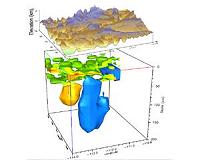| . |  |
. |
Innsbruck, Austria (SPX) May 04, 2011 In one of his songs Bob Dylan asks "How many years can a mountain exist before it is washed to the sea?", and thus poses an intriguing geological question for which an accurate answer is not easily provided. Mountain ranges are in a constant interplay between climatically controlled weathering processes on the one hand and the tectonic forces that cause folding and thrusting and thus thickening of the Earth's crust on the other hand. While erosion eventually erases any geological obstacles, tectonic forces are responsible for piling- and lifting-up rocks and thus for forming spectacular mountain landscapes such as the European Alps. In reality, climate, weathering and mountain uplift interact in a complex manner and quantifying rates for erosion and uplift, especially for the last couple of millions of years, remains a challenging task. In a recent Geology paper Michael Meyer (University of Innsbruck) et al. report on ancient cave systems discovered near the summits of the Allgau Mountains (Austria) that preserved the oldest radiometrically dated dripstones currently known from the European Alps. "These cave deposits formed ca. 2 million years ago and their geochemical signature and biological inclusions are vastly different from other cave calcites in the Alps" says Meyer, who works at the Institute of Geology and Paleontology at the University of Innsbruck, Austria. By carefully analysing these dripstones and using an isotopic modelling approach the authors were able to back-calculate both, the depth of the cave and the altitude of the corresponding summit area at the time of calcite formation. Meyer et al. thus derived erosion and uplift rates for the northern rim of the Alps and - most critically - for a geological time period that is characterized by reoccurring ice ages and hence by intensive glacial erosion. "Our results suggest that 2 million years ago the cave was situated ~1500 meters below its present altitude and the mountains were probably up to 500 meters lower compared to today", states Meyer. These altitudinal changes were significant and much of this uplift can probably be attributed to the gradual unloading of the Alps due to glacial erosion. Dripstones have been used to reconstruct past climate and environmental change in a variety of ways. The study of Meyer et al. is novel, however, as it highlights the potential of caves and their deposits to quantitatively constrain mountain evolution on a timescale of millions of years and further shows how the interplay of tectonic and climatic processes can be understood. Key to success is an accurate age control provided by Uranium-Lead dating. This method is commonly used to constrain the age of much older rocks and minerals but has only rarely be applied to dripstones - i.e. only those with high Uranium concentrations - and luckily this is the case for the samples from the Allgau Mountains.
Share This Article With Planet Earth
Related Links University of Innsbruck Tectonic Science and News
 Rice University geologist leads team effort to solve mystery of the Colorado Plateau
Rice University geologist leads team effort to solve mystery of the Colorado PlateauHouston TX (SPX) Apr 29, 2011 A team of scientists led by Rice University has figured out why the Colorado Plateau - a 130,000-square-mile region that straddles Colorado, Utah, Arizona and New Mexico - is rising even while parts of its lower crust appear to be falling. The massive, tectonically stable region of the western United States has long puzzled geologists. A paper published in the journal Nature shows how magm ... read more |
|
| The content herein, unless otherwise known to be public domain, are Copyright 1995-2010 - SpaceDaily. AFP and UPI Wire Stories are copyright Agence France-Presse and United Press International. ESA Portal Reports are copyright European Space Agency. All NASA sourced material is public domain. Additional copyrights may apply in whole or part to other bona fide parties. Advertising does not imply endorsement,agreement or approval of any opinions, statements or information provided by SpaceDaily on any Web page published or hosted by SpaceDaily. Privacy Statement |